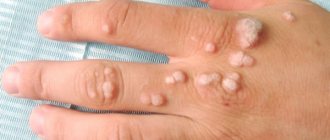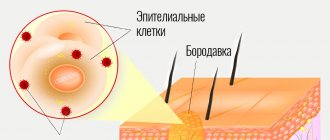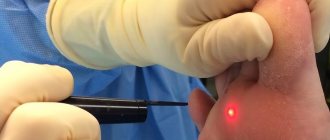Warts are classified as benign neoplasms.
They can appear on various parts of the skin and mucous membranes.
If a wart appears on the lip, it represents a cosmetic defect and can also cause discomfort to its owner, worsening the quality of life.
Forming on the lip, the tumor affects speech and interferes with eating.
A wart can cause pain, especially if it is localized on the mucous membrane inside the lip.
If measures are not taken to eliminate it, the growth may become injured, which will lead to a secondary infection.
Types of warts
A wart is a growth that rises above the surface of the skin or mucous membrane.
Its dimensions, as a rule, are no more than 1 centimeter in diameter.
The tumor can appear on any part of the body, including the face.
On the face, most often a wart forms on the lip, above or below the lip, on the buccal surface of the oral mucosa.
A warty growth can appear on both the upper and lower lips.
The following types of neoplasms are distinguished:
- Common (vulgar) warts. These are growths that have a dense structure, soft to the touch, flesh-colored or yellowish in color. New growths form on the red border of the lips. They are not painful, but tend to itch. Vulgar warts appear on the lips not only in adults, but also in children.
- Flat- shaped growths may appear on the outside of the lips or on the oral mucosa. Their surface is smooth, oval or round in shape. The color of the growth resembles the color of the skin and almost does not rise above it. The location is also the red border of the lips. Flat warts do not hurt, but they are very itchy.
- Hanging neoplasms are located on a thin stalk. At the beginning of development they resemble a bump. They have a brown, pinkish tint or close to the color of the skin.
- Filiform (acrochords). These are small growths that appear after 35 years, but can occur earlier.
- Genital warts . The localization of such growths is the mucous membrane. The new growths are elongated and arranged in groups, resembling a cockscomb or cauliflower inflorescences. The growths are prone to injury, which causes inflammation and bleeding.
The wart forms gradually and almost imperceptibly.
- At the beginning of development, a small compaction forms, which gradually increases.
- A white dot forms on the surface of the mucous membrane of the lip or in the mouth, which gradually turns into genital warts.
To date, approximately one hundred types of papillomavirus have been discovered.
Some types of growths have a benign course, while others are capable of malignancy.
They can provoke the development of cancer.
In addition to the types of growths listed above, there are also senile warts (keratoma, keratosis).
The difference between keratosis is that its appearance is not associated with papillomavirus, and keratoma does not provoke the formation of cancer.
In their development, senile warts go through several stages:
- ✓ brown spots appear, but the wart has not yet formed
- ✓ formation of papules and nodules
- ✓ appearance of keratoma - when you try to scrape off the scales, bleeding appears
- ✓ transition to the cutaneous horn, which is characterized by excessive growth and keratinization of the neoplasm
According to some experts, keratosis and senile warts belong to different diseases.
Questions and answers
What does lip cancer look like?
In terms of external signs, lip cancer at the initial stage resembles a herpetic rash: a small swelling appears, which later turns into one or several ulcers covered with crusts. A thickened area with redness of the skin may form. Unlike a herpetic infection, ulcers do not heal after two to three weeks, but on the contrary, increase in size.
How to recognize lip cancer?
If a lump or swelling appears on one of your lips and does not go away within two to three weeks, you should definitely contact an oncologist to check for lip cancer. It is impossible to independently determine cancer by external signs; laboratory tests are required - histological and cytological examination of tumor tissue, biochemical blood tests, examinations using a tomograph and other types of medical equipment.
How long do people live with lip cancer?
A malignant tumor on the lip is one of the least aggressive oncological pathologies and is most often detected at an early stage. More than 90% of people who develop it live after diagnosis for more than 10 years, i.e. are completely cured of cancer.
Attention! You can cure this disease for free and receive medical care at JSC "Medicine" (clinic of Academician Roitberg) under the State Guarantees program of Compulsory Medical Insurance (Compulsory Medical Insurance) and High-Tech Medical Care. To find out more, please call +7(495) 775-73-60, or on the VMP page for compulsory medical insurance
The difference between a wart and keratoses and cancer
Keratosis may be similar in appearance to melanoma (a type of skin cancer).
Melanoma can begin as a warty growth or as a seborrheic keratosis.
A dermatologist can distinguish them from cancer.
To exclude an oncological process, a biopsy is performed.
The peculiarity of seborrheic keratosis is that the formation is waxy, flat, and there is no pain when touched or at rest.
With cancer, a growth similar to a keratosis may change shape or color.
In this case, you will need to consult a specialist.
Why are papillomas in the mouth dangerous?
The main danger of papillomas on the mucous membranes is the possibility of their malignant transformation, which is accompanied by an oncological process. It cannot be said that this probability is very high, but most doctors agree that if the epilelium grows excessively, atypical cell growth can become uncontrollable.
In addition, papillomas in the mouth are usually accompanied by constant discomfort, which is associated with the location of a large number of nerve endings and sensitive centers on the oral mucosa. Treatment of papilloma in the throat is necessary due to the likelihood of its growth with subsequent problems with speech activity.
Also, treatment of papillomas in the mouth is justified from the point of view that this particular localization is accompanied by the highest risk of injury to the neoplasm. This can happen while eating, talking, or making facial expressions. In this case, severe bleeding occurs, which is very difficult to stop. In addition, a constant humid environment with an abundance of microorganisms prevents the rapid healing of the wound surface and, on the contrary, contributes to wound infection.
Causes of warts
The appearance of warts is caused by infection with papillomavirus or HPV.
Since the skin on the lips is quite thin, it is therefore easily permeable to viruses.
It should be noted that signs of infection with the human papillomavirus do not always occur.
The better the immune system, the less likely it is that symptoms of the disease will appear.
And yet, most of the world's population is infected with HPV.
The incubation period for the development of the disease can be several months or years.
As soon as the immune system fails, the first signs of infection appear.
Activation of the virus is accompanied by the formation of warts.
As a rule, growths appear on the area of the skin or mucous membrane where the pathogen entered the body.
Infection can occur both through sexual contact and through household contact.
Can the virus be transmitted by kissing on the lips?
The most common cases of infection are:
- intrauterine infection of the fetus if a pregnant woman is infected with papillomavirus
- shaking hands or kissing an infected person (if there are wounds or abrasions, the risk of infection increases)
- the use of personal items of an infected person (toothbrush, dishes, lipstick) is unlikely, since the pathogen is not stable in the environment
- sex accompanied by oral sex
- visiting common areas (swimming pool, sauna, shower)
People at risk are those who:
- patients with diabetes mellitus or other pathology of the endocrine system
- suffer from obesity and metabolic disorders
- taking antibiotics for a long time
- have chronic diseases
- suffer from increased sweating, especially on the feet, as this is where plantar warts often form
A malfunction of the immune system can occur for the following reasons:
- If there is a deficiency of essential substances in the body
- After suffering stress or physical exhaustion
- In case of hormone imbalance: during puberty, during pregnancy, with the onset of menopause, during treatment with hormonal drugs
- In case of chronic lack of sleep and overwork
- Due to a recent infectious disease
- If a person abuses smoking and alcoholic beverages
Causes and risk factors
The main cause of lip cancer is a malignant modification of cells located at the border of the transition of the skin epithelium to the mucous membrane. As a result, cells begin to actively divide, which leads to tumor growth and displacement of healthy tissue. What becomes the trigger for the reformatting of the original healthy cell into a cancerous one has not yet been established, but the factors that increase the likelihood of developing pathology are well known:
- prolonged exposure to the open air, due to which the lips are constantly chapped and cracked;
- diseases of the digestive tract, metabolic disorders;
- habit of biting lips;
- unbalanced diet, chronic vitamin deficiency;
- regular consumption of strong drinks that burn the mucous membrane of the lips;
- smoking and microburns of the lips caused by it, the habit of chewing tobacco;
- irritation due to poorly fitting dentures or broken edges of a tooth;
- poor oral hygiene.
Among patients with lip cancer, rural residents who constantly work outdoors predominate. Men get sick two to three times more often than women; the main age group at risk is people over 60 years of age.
Diagnosis of warts
The main diagnostic method is to examine the patient's face for the presence of warts on the lips and oral mucosa.
To confirm or refute the presence of HPV, it is enough to take tests:
- ✓ Blood tests for antibodies
- ✓ To conduct a histological examination (biopsy), a small part of the tumor is taken for analysis
- ✓ The PCR technique allows you to detect the genetic material of a pathogen with one hundred percent probability
Before getting rid of the growth, you should visit an oncologist.
A specialist will use dermatoscopy to determine the condition of the wart to rule out signs of malignancy.
Classification
To classify the disease, the international TNM system is used, where:
- T (tumor) stands for tumor;
- N (nodulus) are lymph nodes that are affected by a tumor;
- M (metastasis) – metastases outside the lymph nodes.
T symbol gradation:
- Tx – there is no data to evaluate the primary neoplasm;
- Тis – preinvasive carcinoma (invasion of the lamina propria or intraepithelial invasion);
- T1 – tumor size up to 2 cm in greatest dimension;
- T2 – tumor size in greatest dimension is 2-4 cm;
- T3 – neoplasm in greatest dimension – more than 4 cm;
- T4a – the neoplasm spreads to neighboring tissues and organs (inferior alveolar nerve, skin of the nose or chin, floor of the mouth, etc.);
- T4b – the neoplasm affects the pterygoid processes, the masticatory zone, the base of the skull, and the carotid artery.
Gradation of the N symbol, which indicates metastases (or lack thereof) in regional lymph nodes (L/N):
- NХ – there is no data for assessing regional l / y;
- N0 – regional lymph nodes are not affected;
- N1 – in one lymph node on the affected side there are metastases up to 3 cm in size in the greatest dimension;
- N2 – in one lymph node on the affected side there are metastases 3-6 cm in greatest dimension; in several lymph nodes on the affected side in the greatest dimension there are metastases up to 6 cm; contralateral or bilateral involvement of lymph nodes with metastases up to 6 cm in greatest dimension;
- N2a – in one lymph node on the affected side there are metastases 3-6 cm in greatest dimension;
- N2b – on the affected side there are metastases in several lymph nodes up to 6 cm in the greatest dimension;
- N2c – contralateral or bilateral involvement of lymph node metastases up to 6 cm in greatest dimension;
- N3 – there are metastases in the lymph nodes more than 6 cm in greatest dimension.
M symbol gradation (distant metastases):
- M0 – no distant metastasis;
- M1 – distant metastases are present.
Stage according to TNM classification
| Stage | T | N | M |
| I | T1 | N0 | M0 |
| II | T2 | N0 | M0 |
| III | T3 | N0 | M0 |
| T1-T3 | N1 | M0 | |
| IV | T4 | N0 | M0 |
| Any T | N2,3 | M0 | |
| Any T | Any N | M1 |
Clinical manifestations of warts on the lip
A wart on the lip does not appear the next day after the papilloma virus enters the body.
The incubation period can last from six months to several years.
This often occurs when the immune system malfunctions.
Having penetrated the skin or mucous membrane, the virus integrates its genetic material into human cells and thus begins to multiply.
As a result, characteristic neoplasms appear at the site of virus introduction.
The pathogen provokes warty growths, disrupting the processes of keratinization of the skin.
Oncogenic strains of papillomavirus change the genetic apparatus of cells in such a way that a malignant formation is formed.
Precancerous diseases of the lips
Precursors of oncology are pathological processes in tissues: inflammation, infection, bacterial damage. All this can provoke the development of oncology.
What diseases can lead to the development of lip cancer:
- Leukoplakia lips.
- Precancerous cheilitis.
- Hyperkeratosis of the red border.
Recently, there has been a tendency for papillomas to degenerate into malignant formations. If a wart appears on the surface of the lips, it should be removed. This will reduce the risk of developing cancer, but will not eliminate it completely. Since HPV is in the blood, which means it can recur when the activity of the immune system decreases.
Obligate precancer
Characterizes itself by the presence in a person of an innate predisposition to the development of malignant formation.
Such diseases include xeroderma pigmentosum, which manifests itself as increased sensitivity of the skin to ultraviolet radiation.
Recommended video:
Is it necessary to remove a wart on the lip?
Removal of the tumor is carried out if there are indications for this.
The growths sometimes disappear spontaneously.
Therefore, if the wart is small and does not cause much concern, then there is no need for removal.
The decision to excise the growth must be made by a specialist.
If a wart causes discomfort in the form of itching, burning, pain, grows, becomes inflamed, or changes in appearance.
If it has increased in size, changed shape and color, or is bleeding, then it must be removed by resorting to excision by one of the methods.
Removing a tumor at home is not safe.
As a result of incorrect actions:
- It may not be possible to remove the wart completely, which will cause its reappearance
- the risk of injury to healthy tissues that surround the growth increases
- scars and cicatrices may form
Benefits of onco
For more than 30 years, onco has been working for the health and comfort of patients with oncology. During this time, we have developed an ideal efficiency formula, which includes:
- maximum safety;
- exact compliance with domestic and international standards and protocols;
- experienced and competent oncologists, diagnosticians, laboratory technicians and consultants;
- modern and high-tech medical equipment;
- uncompromising comfort and support for patients at every stage of therapy.
The high level of service and quality of services has been repeatedly confirmed by numerous certificates and awards. Most of the doctors working for us have trained in medical institutions in the USA and Europe, learning from the invaluable experience of their foreign colleagues.
In our work, we achieve amazing results not only thanks to modern equipment and a staff of true professionals. Our patients feel safe and comfortable, as all rooms of the oncology center are beautifully designed. The furnishings and interior are imbued with a favorable atmosphere, far from a hospital one. Also available to patients and those accompanying them is a pharmacy, a cozy cafe and a rooftop restaurant with panoramic views.
Two onco buildings have extensive territories; The buildings themselves house many offices, departments and treatment rooms. To prevent you from getting lost, our employee will guide you to the right door. Finding a place for your car will also not be a problem: we have a large parking lot.
Wart treatment
Treatment of any growth on the lips begins with a medical examination and determining whether the growth is malignant.
Next, the doctor selects a method of therapy.
In case of a malignant form, the patient is referred to an oncologist, who will decide how to treat the patient.
Treatment of the disease is complex.
Treatment consists of the main stages: removal of the growth and drug therapy.
Removal of the tumor can be done in one of the following ways:
- ✓ Using pharmaceutical products
- ✓ In a medical institution where modern excision techniques will be used
- ✓ Folk remedies. The use of alternative medicine methods must be agreed with a doctor
Diagnosis and treatment of lip cancer in Moscow
If you find signs of lip cancer, contact the Meditsina clinic for a comprehensive examination and confirmation or refutation of suspicions. At your service:
- exclusive diagnostic equipment;
- own laboratory performing all types of analyses;
- oncologists of the highest category who will conduct treatment;
- a well-equipped inpatient department;
- medical service of international level.
Call us to find out the details you are interested in and schedule a consultation.
Pharmacy products for removing warts
You can buy medications at the pharmacy that will help you deal with warts at home.
Among them:
- Super clean . The product is an alkaline solution that has a chemical effect on the growth, causing cauterization.
- Cryopharma, Wartner . These agents cause cryodestruction of the wart; as a result of cold exposure, the neoplasm is frozen.
- Solcoderm . A drug containing acids that have a cauterizing and mummifying effect on pathological tissues.
- Immunomodulators – Viferon, Oxolinic ointment will help increase immunity and the body’s fight against the virus.
- Antiviral agents – Isoprinosine, Interferon.
The use of cauterizing agents on the lips and face is extremely undesirable; application of these agents to the oral mucosa is especially dangerous.
Wart removal in the clinic
The clinic uses modern hardware techniques to excise growths:
- Laser therapy . The method allows you to quickly and without blood remove the growth. There is no discomfort during the procedure, as pain relief is performed. During one session, you can get rid of several tumors in a very short time. The method is suitable not only for adults, but also for children. The likelihood of relapse is minimized. Skin defects in the form of scars after laser use are very rare.
- Radio wave therapy . The technique is considered the safest. When excising a wart using a radio wave, there is no contact with the skin. It is not always possible to completely remove the growth. The procedure leaves no traces of impact.
- Electrocoagulation . The procedure requires anesthesia. Using an electrode to which a high-frequency electric current is applied, the wart is burned out, followed by cutting off the growth with a special metal loop. Scarring may appear after removal.
- Cryodestruction . Liquid nitrogen is used and the wart is treated until it turns white. As a result of exposure to low temperatures, the growth tissues die. There is no need for anesthesia for the manipulation. The disadvantage of the technique is the lack of control over the depth of nitrogen exposure. For this reason, frequent relapses occur.
- Surgical. Removal is done using a scalpel. The disadvantage of the procedure is the formation of a scar, so this technique is used only for certain indications (in case of malignancy of the process and large size of the wart).
Symptoms
The entire process of development of cancer affecting the lips can be described as follows:
- lip tissue thickens;
- it progressively increases, ulceration appears in the center of the tumor;
- it becomes crusty on top, and raised ridges form along the edges of the ulcer.
It is these external symptoms that appear at the beginning and give reason to suspect malignant development. In most cases, the lump is localized away from the center and corners of the mouth - tumors rarely occur in these places.
In addition to external signs, the patient develops symptoms of a general deterioration of his condition:
- constant weakness;
- slight loss in body weight;
- decreased appetite;
- frequent headache;
- temperature up to 37.8 °C for a long time.
It is worth noting that general symptoms may be the only manifestation of the disease at the initial stage. Externally, the tumor may not yet show itself. And only with the progression of the disease external signs appear. They are also accompanied by other symptoms:
- pain in the affected area;
- severe itching of the skin;
- discomfort and pain when eating.










